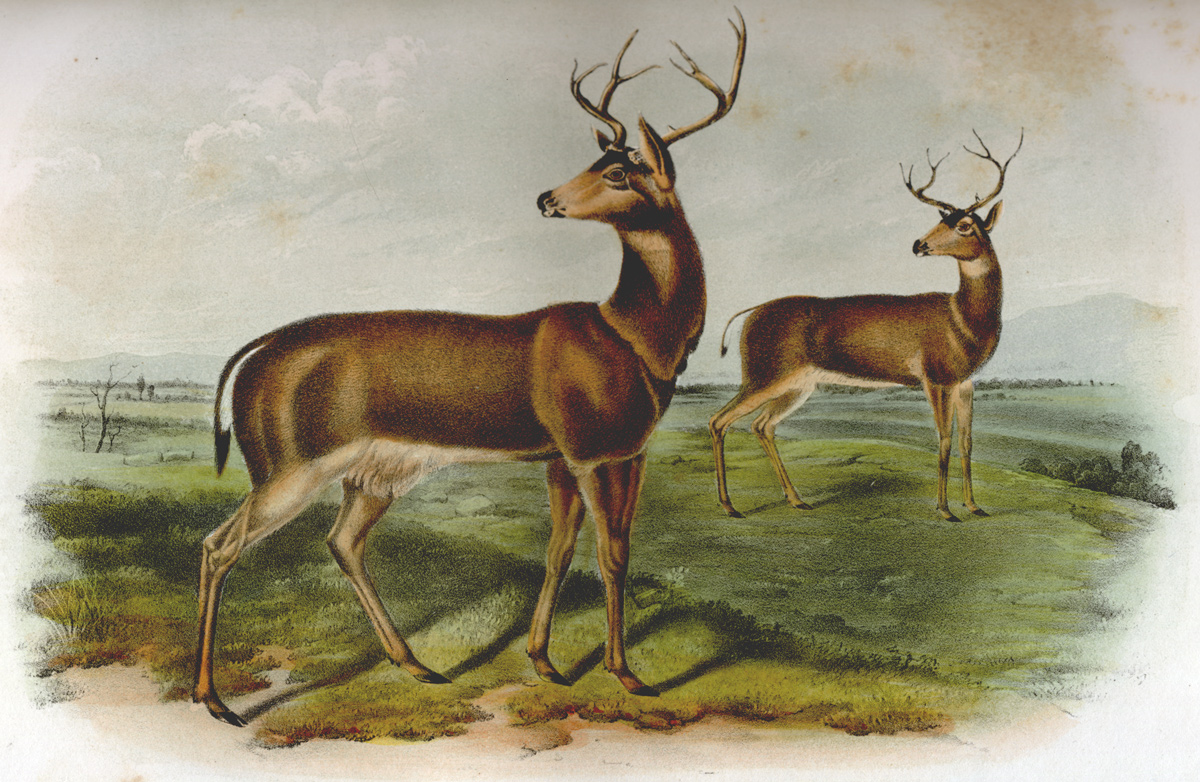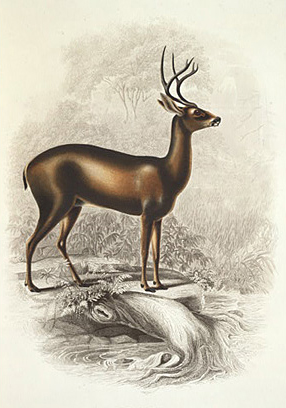Another Curious Deer
Columbian Black-Tailed Deer
Odocoileus hemionus columbianus
Courtesy Special Collections and Archives, University of Idaho Library, SPEC QL715A9 1849.
Drawn from Nature by J. W. Audubon; On Stone by Wm. E. Hitchcock; Lithograph Printed & Colored by J. T. Bowen, Philadelphia” Original size, 8 in. x 4 in.
Ears, nostrils and eyes focused upon some potential danger behind them, muscles tautly poised for action, these two figures, captured with photographic spontaniety by John James Audubon‘s son John Woodhouse, radiate the vital energy pulsing thorugh the flesh and blood beneath their tawny coats.
The antlers reflect the Columbian blacktail’s genetic connection with the mule deer. Audubon has inexplicably omitted the preorbital glands, then still known as “lachrymal” openings.
During his exploration of the coast north of Cape Disappointment on 19 November 1805, Clark observed “Some curious Deer on this Course darker large boded Shorte legs Pronged horns & the top of the tale black under part white as usial.” In his journal entry for that day he clarified his hasty field note, and added a couple of details: “The Deer of this Coast differ materially from our Common deer in a[s] much as they are much darker deeper bodied Shorter ledged horns equally branched from the beem the top of the tail black from the rute to the end Eyes larger and do not lope but jump.” The next substantive information about the species was in Lewis’s paragraph, written at Fort Clatsop on 19 February 1806, which Nicholas Biddle revised only slightly for his paraphrase. Nothing more detailed about this discovery appeared anywhere in the original journals, but Lewis’s conviction that the “black tailed fallow deer of the coast” and the “common fallow deer” were two distinct species was sufficient to urge later investigators to try to clarify them.
Bachman’s Contributions
As both a zoologist and an artist, Titian Ramsay Peale was among the prestigious team of scientists and artists who accompanied the United States Exploring Expedition of 1838-1842, commanded by Captain Charles Wilkes (1798-1877). Peale reported: “This deer was first seen . . . by our adventurous countrymen, Captains Lewis and Clark, whose description . . . is so accurate, that we subjoin it entire . . . . We propose the name Lewisii, from the conviction that the above description, written forty years since on the Columbia River, was intended for the animal now before us.”[1]Titian Ramsay Peale, United States Exploring Expedition, . . . Vol. VIII, Mammalia and Ornithology (Philadelphia: C. Sherman & Son, 1848), 40-41.
Peale’s “Columbian blacktail” is an example of virtuoso lithography, but compared with J. W. Audubon’s alert, princely figures set in a semblance of their natural habitat, Peale’s is a cold, boneless figurine posed in an artificial wilderness.
Comparisons between European and American specimens continued to remain significant for several decades, although they contributed little toward taxonomic solutions. The 1815 U.S. edition of Guthrie’s New Geographical . . . Grammar[2]William Guthrie, A New Geographical, Historical, and Commercial Grammar, and Present State of the Several Kingdoms of the World, 2 vols. (Philadelphia: Johnson & Warner, 1815), 2:166. quoted only Biddle’s paragraph on the “black-tailed fallow deer,” and added the irrelevant and probably erroneous opinion, based on Lewis’s description of the tail, that the same species had been introduced into Spain from California. Thirty years later, John Bachman correctly observed that “The antlers may be said to bear some resemblance to those of the Red Deer of Europe, much greater than do those of the Virginian Deer or Elk.” Furthermore, he declared, “The gait of this species is not so graceful as that of the Virginian Deer, it bounds rather more like the roebuck of Europe than any other of our Deer except the Long-tailed Deer [the Rocky Mountain whitetail], and is reported to be very swift.”[3]John James Audubon and James Bachman, Quadrupeds of North America, 3 vols. (Philadelphia, 1839-54), 2:254.
By the late 1840s the known range of the Columbian blacktail had been extended as far as the gold fields of coastal California, as Bachman explained:
This beautiful Deer is found variously dispersed over the western portions of the North American continent, where it was first noticed by LEWIS and CLARK, near the mouth of the Columbia River; but not until the discovery of the golden treasures of California did it become generally known to white men. In that country, along the hill sides and in the woody dells and “gulches,” the hardy miners have killed hundreds, nay thousands, of Black-tailed Deer; and it is from the accounts they have given that it is now known to replace, near the great Sierra Nevada, the common or Virginian Deer which is found east of the Rocky Mountains; all the hunters who have visited California, and whom we have seen, tell us that every Deer they shot there was the Black-tailed species.
He added some new observations that Lewis had overlooked. “There is a tuft of long pendulous hairs hanging down from the umbilicus backward to between the thighs,” which Audubon delicately illustrated.
Bachman’s account is protracted by a tedious tale about John Woodhouse Audubon and his party hunting Columbian whitetails for sale to miners on the California coast near Stockton, adding that more than one luckless prospector had made a decent living mining Columbian blacktail deer in lieu of gold.
Continued Uncertainty
His concluding remarks reflect the continuing uncertainty among zoologists about the proper classification of Lewis’s “blacktail fallow deer.”
According to our present information, there is only one specimen of this Deer in the collections of objects of natural history in Europe, and this is in the museum of the Zoological Society in London, where it was, when we saw it, (erroneously) labeled C. Macrotis.
At the Patent Office in Washington city there is a skin of a Deer (one of the specimens brought from the northwest coast of America by the [Wilkes] Exploring Expedition), which has been named by Mr. PEALE C. Lewisii.
We have not positively ascertained whether it be distinct from our C. Richardsonii, but presume it will prove to be well separated from it, as well as from all our hitherto described Deer, and we shall endeavour to figure it, if a good species, and introduce it into our fauna under the name given it by MR. PEALE.
The British zoologist Sir John Richardson, who was one of three naturalists with the Northern Land Expedition under Captain Sir John Franklin in 1827-28, failed to get a specimen of this species, and knew it only from Lewis’s—that is, Biddle’s—account. Nevertheless he took the liberty of proposing the name Cervus richardsonii.[4]Sir John Richardson (1787-1865), Fauna Boreali-Americana: or, The Zoology of the Northern Parts of British America, Containing Descriptions of the Objects of Natural History Collected on the Late … Continue reading It didn’t stick.
“Distinct species” or not, the confusion was yet to be resolved.
Recent Developments
Both Lewis and Clark took it for granted that the scientists who followed them into the Northwest would either confirm or re-evaluate and consolidate their discoveries of new flora and fauna, but it would have been idle for either of them to speculate about what might actually transpire, just as it is pointless for us to predict what will have come about in the field of zoology or botany by the time the Lewis and Clark tricentennial rolls around.
The question is, where are we now? As we said at the outset of this chapter on deer, new technologies can change our understanding of genetic relationships, and modify the science of taxonomy. One example resides in the recent history of the cervid that Clark found on the Pacific Coast, which he and Lewis variously referred to as the—in 21st-century terms—Columbian blacktail, Odocoileus hemionus [“half-ass” or “mule”] columbianus. They wrote as if they viewed it as a mule-whitetail hybrid. In the 1990s, however, a comparison of mitochondrial DNA among specimens of all three species has clearly suggested that it was actually the mating of blacktail bucks with whitetail does that produced the mule deer.[5]Valerius Geist, Mule Deer Country (Minnetonka, Minnesota: NorthWord Press, 1999), 29, 33.
Notes
| ↑1 | Titian Ramsay Peale, United States Exploring Expedition, . . . Vol. VIII, Mammalia and Ornithology (Philadelphia: C. Sherman & Son, 1848), 40-41. |
|---|---|
| ↑2 | William Guthrie, A New Geographical, Historical, and Commercial Grammar, and Present State of the Several Kingdoms of the World, 2 vols. (Philadelphia: Johnson & Warner, 1815), 2:166. |
| ↑3 | John James Audubon and James Bachman, Quadrupeds of North America, 3 vols. (Philadelphia, 1839-54), 2:254. |
| ↑4 | Sir John Richardson (1787-1865), Fauna Boreali-Americana: or, The Zoology of the Northern Parts of British America, Containing Descriptions of the Objects of Natural History Collected on the Late Northern Land Expedition, Under Command of Captain Sir John Franklin, R.N. (London: J. Murray, 1829-37). |
| ↑5 | Valerius Geist, Mule Deer Country (Minnetonka, Minnesota: NorthWord Press, 1999), 29, 33. |
Experience the Lewis and Clark Trail
The Lewis and Clark Trail Experience—our sister site at lewisandclark.travel—connects the world to people and places on the Lewis and Clark Trail.
Discover More
- The Lewis and Clark Expedition: Day by Day by Gary E. Moulton (University of Nebraska Press, 2018). The story in prose, 14 May 1804–23 September 1806.
- The Lewis and Clark Journals: An American Epic of Discovery (abridged) by Gary E. Moulton (University of Nebraska Press, 2003). Selected journal excerpts, 14 May 1804–23 September 1806.
- The Lewis and Clark Journals. by Gary E. Moulton (University of Nebraska Press, 1983–2001). The complete story in 13 volumes.



